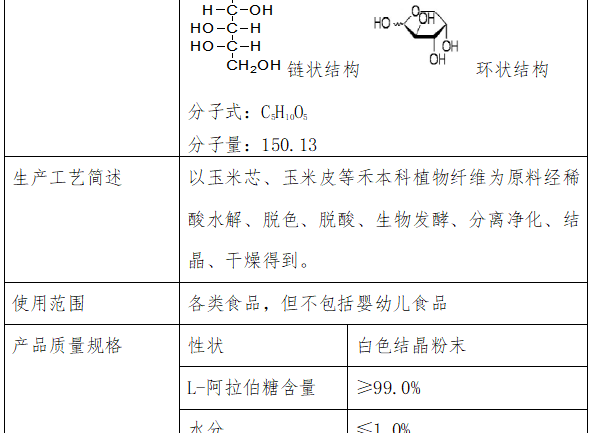How does L-arabinose step out of the limitation of inhibiting sucrose?
“Sugar reduction, sugar lowering and sugar substitution” has become an inevitable trend in the development of the global natural health products industry, especially in the food and beverage industry. Sugar tax policies implemented in many countries around the world, the spread of obesity and diabetes, and the increase in consumers’ awareness of their own health care are the main reasons for the global trend of sugar reduction.
L-Arabinose is a low-calorie functional sweetener that tastes very similar to sucrose, and its most notable effect is to inhibit the body’s absorption of sucrose.
L-Arabinose and Sucrose Inhibition
Arabinose is named after Gum Arabic, a natural five-carbon aldehyde sugar that was first extracted from the colloid secreted by the Arabis tree through complex chemical and physical methods. Its chemical formula is C5H10O5, and it is also known as L(+)-gum aldose, L(+)-Arabinose, pectinose, and so on.
There are a total of 8 stereoisomers of arabinose, of which natural L-arabinose is widely found in a variety of foods and rarely exists in the form of monosaccharides, usually combined with other monosaccharides in the form of heteropolysaccharides in gums, hemicellulose, pectic acid, bacterial polysaccharides, and certain glycosides.
The biggest difference between L-arabinose and other sugar substitutes is that L-arabinose is a natural sugar extracted from plants, which can be used in combination with sucrose to ensure the taste and physicochemical properties of the original sucrose-added food, while achieving the purpose of lowering the intake of sugar. People can enjoy the real “sugar” while consuming “low-sugar” food to meet the demand of “sweet taste”.
What’s more, L-arabinose can inhibit the decomposition of sucrose into glucose and fructose into the bloodstream by combining with sucrase enzyme in the small intestine, thus controlling the rise of blood sugar.
Development process of L-Arabinose
1. In 1998, L-Arabinose was approved as a health food additive by the U.S. Food and Drug Administration (FDA) and the Japanese Ministry of Health and Welfare (MHLW).
2. In 2001, the Japanese Ministry of Health and Welfare included L-arabinose as a health food additive for regulating blood glucose in its list of specific foods for health care.
3. The American Medical Association includes L-arabinose as a nutritional supplement or over-the-counter drug as an anti-obesity agent. Scope of use: All kinds of food, but not including baby food. The recommended daily intake is 3-6% of sucrose.
4. In 2008, the Ministry of Health of China approved L-arabinose as a new resource food, stipulating that it can be used in all kinds of food, but not including baby food.

Application of L-Arabinose
Currently, food products containing L-arabinose are divided into two categories: the first category is to directly market high-purity L-arabinose in the form of chewable tablets and capsules, with the addition of chromium-rich yeast and bitter gourd extract, which together play a role in controlling blood glucose;
The second category is to use L-Arabinose as a food ingredient, instead of sucrose, to be added into food or beverage to slow down the rise of blood sugar in human body caused by sucrose-based food. Small food partner network competing database search, search shows that the domestic L-arabinose commonly used in the field of milk powder, confectionery, solid beverages, and its application ratio were 5.4 ‰, 6.7 ‰, 1.48%, now uploaded part of the product picture and ingredient list for you to show L-arabinose in the specific application of the product.
01
Application in milk powder Wundashan, Feihe, Sanyuan products actual photo Source food partner network competitor database
Wundashan Golden Season Sugar Ning High Dietary Fiber Light Formula Milk Powder Raw cow’s milk, skimmed milk powder, desalted whey powder, inulin, resistant dextrin, L-arabinose (additive amount: 4.85g/100g), calcium carbonate, oat β-glucan (additive amount: 291mg/100g), retinyl acetate, cholecalciferol, dl-alpha tocopherol acetate, pyridoxine hydrochloride, taurine, folic acid, L ascorbic acid, L-carnitine, ferrous sulfate, zinc sulfate, sodium selenite, magnesium sulfate.
Feihe Aiben Clear Milk Powder Raw cow’s milk, skimmed milk powder, resistant dextrin (15% added), desalted whey powder, inulin (5% added), selenium-enriched yeast, L-arabinose, Vitamin A, Vitamin D, Vitamin E, Vitamin C, Calcium carbonate, Zinc gluconate.
Sheng Yuan Uibo Bei Ou Pure Zhen Nutritional Milk Powder for the Middle-aged and Elderly High Oil Whey Powder [desalted whey (additive amount 27%, in terms of dry matter), edible plant blended oil (soybean oil, sunflower oil, rapeseed oil, coconut oil), phospholipids, Sodium L-Ascorbic Acid, Mixed Tocopherol Concentrate, Ascorbyl Palmitate], Whole Milk Powder (additive amount 30%), Skimmed Milk Powder (additive amount 24%), Polydextrose, Oligomeric Isomaltose, Inulin, Rhizoma Polygonati Odorati, Cassia Seed Powder (additive amount 3,‰%), Cassia Seed Powder (additive amount 3,‰%), Pueraria Mirifica Powder (additive amount 3,‰%), L-arabinose (additive amount 1,‰%), phytosteryl esters (additive amount 1,‰%), oat β-glucan (additive amount 0,1‰%), bamboo leaf flavonoids (additive amount 0,1‰%), Bifidobacterium Lactis Bi-07
Vitamins: sodium L-ascorbate, retinyl acetate, cholecalciferol, dl-α-tocopherol acetate
Minerals: calcium carbonate, ferrous sulfate, zinc sulfate, sodium selenite
02
Application in candy
BY-HEALTH Everyday Plus Sparkling Candy Pressed Candy Passion Fruit Flavored Sorbitol, Lactose, Citric Acid, Sodium Bicarbonate, Magnesium Stearate, L-Arabinose, Instant Green Tea (Containing Tea Polyphenols ≥30%, Additive 0.17%), Vegetable and Fruit Enzyme Powder, Stevia Glycosides, Sucralose, Aspartame (Containing Phenylalanine), Natural Menthol, Lemon Yellow Aluminum Precipitate, Edible Flavoring
Besunyen Break Control Program White Kidney Bean Pressed Tablet Candy Maltitol, L-Arabinose, Resistant Dextrin, White Kidney Bean Extract, Flavor, Citric Acid, Acerola Cherry Powder, Green Coffee Bean, Yeast Extract, Sodium Citrate, Magnesium Stearate, Sucralose, Hydroxypropyl Methylcellulose, Titanium Dioxide, Polyethylene Glycol
ZiGuang JinOli White Kidney Bean and Lotus Leaf Pressed Candy Sorbitol, White Kidney Bean Powder (Solid Beverage) (White Kidney Bean Powder, Maltodextrin), Lotus Leaf Extract (Solid Beverage), Erythritol, L-Arabic Sugar, Flavoring for Food, Magnesium Stearate, Ginger Powder (Solid Beverage), Green Coffee Powder, Psyllium Round Pod Hull Powder
03
Applications in solid beverages
Flavorful Mung’s Tea Flavored Solid Drink Soymilk Matcha Instant Soybean Powder (Soybean, Maltose Syrup), Edible Dextrose, Sugar, Matcha Tea Powder, L-Arabinose
LONGEVITY Bohotang L-carnitine tartrate (L-carnitine tartrate), chitosan, table salt, food flavor (guarana extract), food additives (citric acid, malic acid, sucralose), food additives (citric acid, malic acid, sucralose). (Sucrose)
Bright Energy Light Ready-to-Eat Probiotic Powder Boxed Erythritol, Oligofructose, Resistant Dextrin, Edelweiss Sugar, Passion Fruit Juice Powder (Maltodextrin, Passion Fruit Juice Concentrate), Whey Protein Concentrate, Bifidobacterium Lactis B420, Lactobacillus acidophilus NCFM, Lactobacillus plantarum ST-III, Polydextrose, L-Arabinose (Additive amount 1g/100g), White Kidney Bean Extract (Additive amount 333mg/100g), vitamin C, citric acid, calcium silicate.
Analytical Outlook
The global food-grade L-arabinose market size reached $139 million (CNY) in 2022, and according to Raystar Consulting forecast the global food-grade L-arabinose market size will reach $216 million by 2028 at a CAGR of approximately 7.46%.
Compared with other sugar substitutes, L-arabinose is not widely used in the market, I analyze that there may be the following 2 reasons:
(1) The high cost of L-arabinose, the price has no advantage over other common sugar substitutes. (L-arabinose is about 50% of the sweetness of sucrose, erythritol is about 60% -80% of the sweetness of sucrose, aspartame is about 200 times the sweetness of sucrose) Figure source 16882) L-arabinose role is limited L-arabinose has a wide range of applications and a better taste, but it can only block sucrose, can not block other starch polysaccharides, fructose syrup, fructose, glucose. For the general public, the main source of sugar is starchy staples, L-arabinose role is more limited.
Editor’s point of view: L-arabinose is a sugar extracted from plants, with natural ingredients food properties, to adapt to the current consumer demand for healthy products. But manufacturers also need to upgrade technology, reduce product costs and improve product market competitiveness.
In addition, food ingredients companies may be able to warm up, through the compounding of raw materials to make the product play the role of 1 + 1 > 2. According to the competitor database: in the application of L-arabinose products have been more than 1/3 of the products also applied to the white kidney bean extract. Through the white kidney bean extract to inhibit the absorption of starch, starch and sucrose double inhibition, play a synergistic effect.
